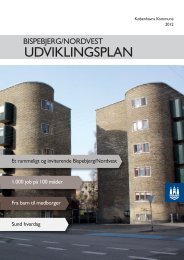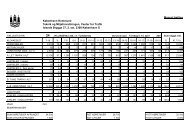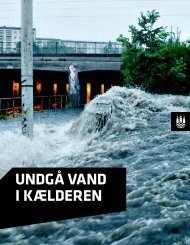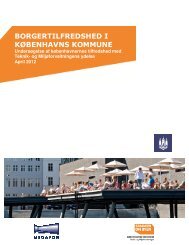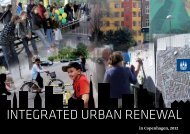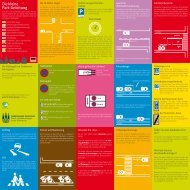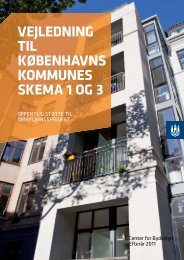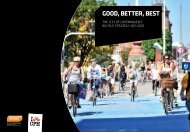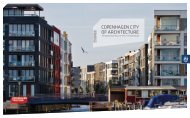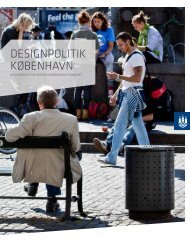SUSTAINABILITY IN CONSTRUCTION AND CIVIL WORKS - Itera
SUSTAINABILITY IN CONSTRUCTION AND CIVIL WORKS - Itera
SUSTAINABILITY IN CONSTRUCTION AND CIVIL WORKS - Itera
You also want an ePaper? Increase the reach of your titles
YUMPU automatically turns print PDFs into web optimized ePapers that Google loves.
36<br />
It is the City of Copenhagen’s vision not to extract more drinking water<br />
than can be replenished. Water consumption must consequently be<br />
reduced. The goal is for average water consumption in 2012 not to exceed<br />
90 litres per person per day in households and 30 litres per person per<br />
day in business and industry. By planning piping and choosing the right<br />
fixtures and equipment, lower-than-average consumption can be achieved<br />
in new construction and urban-renewal projects.<br />
It is the City of Copenhagen’s overall goal for rainwater to be discharged,<br />
channelled, and/or percolated locally in order to maintain the groundwater<br />
levels and qualities under the City that supplies it with drinking water and<br />
in order to augment the water in lakes and watercourses. (See the City of<br />
Copenhagen’s wastewater plan, 2008.)<br />
Climate changes and stricter environmental standards mean that in the<br />
future, sewers will be too small to accommodate the increased amount of<br />
rain. In order to prevent overloading the drainage system, the discharge of<br />
rainwater into the system must be reduced as much as possible. This will<br />
prevent bodies of water from being polluted by wastewater from stormwater<br />
releases and reduce the load on sewage-treatment plants. The City<br />
of Copenhagen has decided that these problems should be solved locally,<br />
so that rainwater is collected, used, evaporated, percolated, or discharged<br />
where it falls. Strategies of this type are called Sustainable Urban Drainage<br />
Systems SUDS (lokalafledning af regnvand (LAR) in Danish). The strategy<br />
will be used to adapt the City’s discharge of rainwater to future climate<br />
changes as well as current conditions.<br />
Peblinge Dosseringen 24; Copenhagen, Denmark, Byens Tegnestue, 2009<br />
A green roof was used for the fi rst time on an historic multi-storey building in Copenhagen<br />
when a new roof terrace was added to it. There is a tradition in Denmark for using green<br />
roofs, but mostly on single family homes or small buildings. Now the technique has been<br />
developed so that mats are available with different plants. Some mats are so light that<br />
roofs do not need to be reinforced.<br />
Augustenborg; Malmö, Sweden, Malmö Municipality, 2003<br />
3000 residents, 1800 units, 32 ha.<br />
For many years, Augustenborg was plagued by flooded cellars sometimes as often as<br />
ten times a year. When the neighbourhood underwent community regeneration, the new<br />
landscaping included open channels, ditches, retaining pools, reeds and small lakes,<br />
through which rainwater runs, is delayed, collected, percolated, and eventually evaporates.<br />
These water elements and features allow rainwater to be used for recreation. Rainwater<br />
conducted in pipes under the asphalt ball court cools it in the summer and reduces<br />
energy consumption when it is transformed into an ice-hockey ring in the winter. The<br />
amount of rainwater lead to the sewage system has been reduced by 40%.


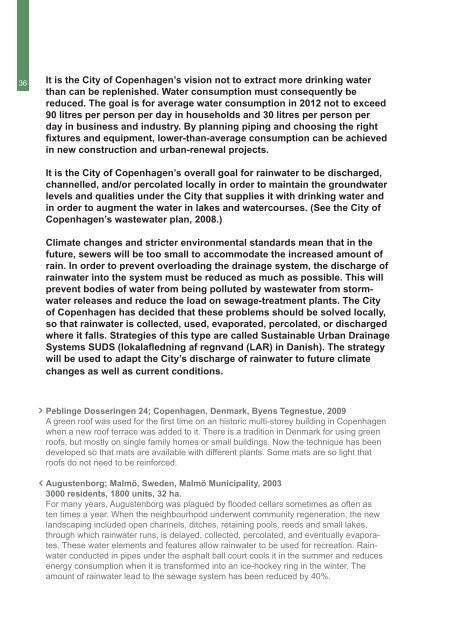
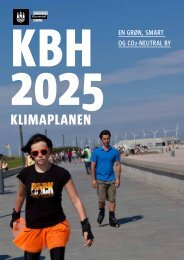
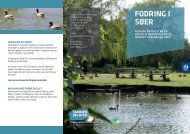
![Lokalplan 301[1] - Itera](https://img.yumpu.com/49288321/1/184x260/lokalplan-3011-itera.jpg?quality=85)
